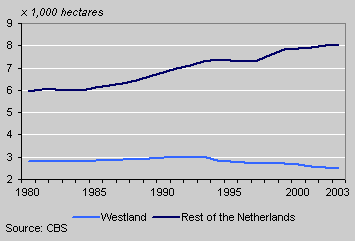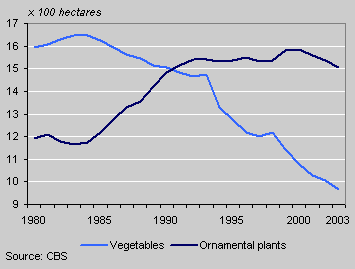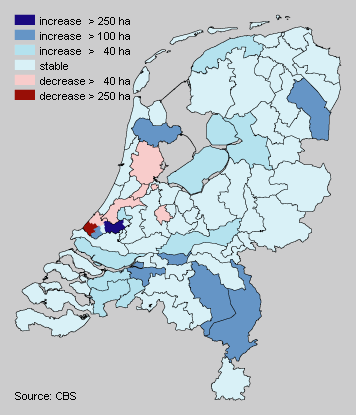Westland horticulture: fewer vegetables

The Westland region to the west of Delft is traditionally the area where glasshouse horticulture in the Netherlands is concentrated. The area of glasshouses used to grow vegetables in this region has decreased since 1985. It has partly been replaced by the cultivation of ornamental plants. In the period 1980-2003 the total area of horticulture under glass in the Westland region fell by 300 hectares to around 2,500 hectares. The total area of glasshouses in the Netherlands rose from 8,800 to 10,500 in the same period.
Area of glasshouses

Vegetables out, ornamental plants in
The area of vegetables grown under glass in the Westland region fell from 1,600 hectares in 1980 to 1,000 hectares in 2003. The ornamental plants which have replaced vegetables are mostly houseplants and garden plants. The area devoted to ornamental plants rose from 1,200 hectares in 1980 to 1,500 hectares in 2003.
Area of vegetables and ornamental plants under glass in the Westland

Tomatoes, cucumbers and peppers
Tomatoes, cucumber and peppers are the most common vegetables grown in Dutch glasshouses. Together they account for two-thirds of the total area of vegetables grown under glass. The area of peppers has risen strongly since 1980: from 200 hectares to 1,200 hectares in 2003. The area of tomatoes nearly halved in the same period, from 2,200 to 1,200 hectares.
Smaller area in Westland, expansion elsewhere
While the area of glasshouse horticulture has diminished in the Westland region, in the rest of the country it has increased. Areas that have shown a strong rise in glasshouse horticulture are: Oostland, Midden Delfland , West Brabant, the western Peel area, North Limburg, Bommelerwaard, West -Friesland and the area around Emmen.
Areas of glasshouse horticulture

Ruud Luijendijk